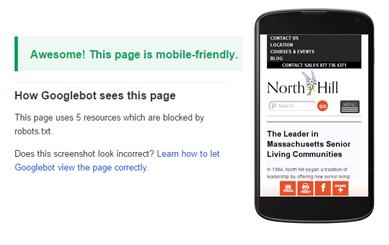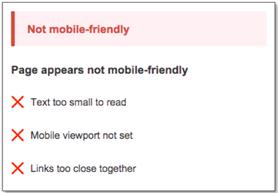April 21st marked the launch of Google’s latest algorithm update that is making significant waves for many businesses and their websites. The change positions mobile-friendly sites at the top of online searches conducted from mobile devices, making non-mobile friendly sites more difficult to find.
For the many businesses targeting older adults that rely on organic (unpaid) search as a primary driver of website traffic, this could mean a major negative impact on their results; hence the creatively-coined term, “Mobilegeddon.” As you’ll read below, the use of mobile devices continues to increase across all ages, so your website should be responsively designed to effectively reach the growing number of mobile users.
What Exactly Is A Mobile-Friendly Site?
According to Google’s John Mueller, “A mobile-friendly site is one that you can easily read and use on a smartphone, by only having to scroll up or down. Swiping left or right to search for content, zooming in to read text, or not being able to see the content at all make a site harder for users on mobile phones.”
Google’s Mobile-FriendlyTest makes it easy to see how your site stacks up to this new algorithm. Hopefully you see a message like the one:
If you don’t get a mobile-friendly diagnosis, you’ll see this:

This ‘not-mobile-friendly’ ranking means that it’s time to look at your website and identify how you can adjust your site design to comply with this change.
Do Older Adults Even Use Mobile Devices?
There is a silver lining: if your audience is the mature consumer, you can take a breath and not panic (yet). At this stage in the game, Nielson reports that 46% of 65+ers own a smartphone. But only 19% of them use their smartphones for internet use.
Similarly, Pew reports 25% of those aged 65+ now own a tablet (a 38% increase in just a year), and that number is on the rise. Therefore most organic traffic for websites targeting older adults comes from desktop searches – and this algorithm update will not affect those searches.
While the world is going mobile fast, the realm of mature consumers is moving at a different pace. But that doesn’t mean you shouldn’t consider a mobile-friendly site, as the number of smartphone and tablet users for those aged 50+ is rising (and rising quickly).
What To Do Now
Getting ahead of the game and going responsive is your best bet to ensure your website renders the best across all devices – desktop, mobile and tablet – so that when your prospects do catch up to the younger population, your site is ready.
When you check your site and find that it is “not mobile-friendly” – don’t panic. But DO make a near-term plan for converting your site to a responsive design platform to give your prospective residents an optimal user experience, no matter what device they view it on.
If you want some guidance on where to start – drop us a line.
RELATED:


